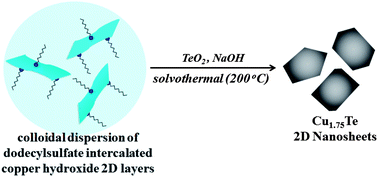Synthesis and thermoelectric behaviour of copper telluride nanosheets
Abstract
Developing reliable synthetic methods for the fabrication of nanostructures of prospective materials is vital for emerging technologies like thermoelectrics that are in need of a breakthrough. In thermoelectrics nanostructuring can potentially enhance phonon scattering while preserving electrical conductivity due to the different length scales of phonons and electrical carriers. A solvothermal reaction between a colloidal dispersion of dodecylsulfate intercalated copper hydroxide layers in ethylene glycol and an alkaline solution of TeO2 was found to successfully yield single crystalline 2D nanosheets of copper telluride, Cu1.75Te. Ethylene glycol reduces TeO2 to Te2− and Cu2+ to Cu+ leading to the formation of Cu1.75Te. The solvated copper hydroxide layers act as templates to facilitate the formation of nanosheets. The nanosheets are a few nanometers in thickness and their lateral dimensions are in the order of micrometers. Thermoelectric measurements suggest that the nanosheet fabrication helps in dramatically decreasing the lattice thermal conductivity thereby increasing ZT.


 Please wait while we load your content...
Please wait while we load your content...